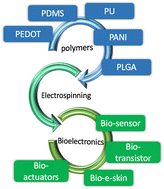Functional electrospun polymeric materials for bioelectronic devices: a review
Abstract
Bioelectronics has excellent potential to enhance the quality of life. It works by interfacing biomaterials with electronic devices, which are then applied to the monitoring, diagnosis, and treatment of the in vivo and in vitro conditions of the human body. On this account, we have explored numerous works on polymer-based bioelectronics at our disposal to adopt a facile fabrication method – electrospinning. Bioelectronic devices typically encompass biosensors, which detect biological analytes resulting in the detection of biomarkers, and bio-batteries which are able to supply non-intermittent micropower required for operating devices. On the other hand, energy harvesting devices, such as biofuel cells and nanogenerators, have the potential to generate energy. Bio-transistors and bio-actuators are used in flexible, wearable, and portable bioelectronics for human health assessment and effective artificial locomotion. Electrospun polymeric materials have shown advantages such as generating convenient microstructures, improved functionalization, and low manufacturing costs over the last few years. Initially, this article provides an overview of the unique structure and features of electrospun nanofiber materials and their application in bioelectronics. Then, it summarizes the recent progress along with future recommendations to conclude. Thus, this study examines the potential of electrospun polymers in bioelectronics by systematically discussing the fabrication and notable improvement of the devices in medical applications.

- This article is part of the themed collection: Recent Review Articles


 Please wait while we load your content...
Please wait while we load your content...